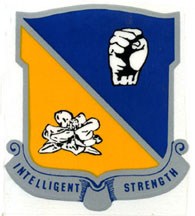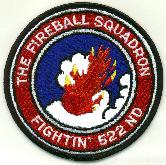The shield was approved on 12th September 1940. The colours represent the Air Force with the Clenched Fist representing Strength and the Magnolia, the Louisiana state flower representing the Groups station of origin.
27th Fighter-Bomber Group
The 27th Bomb Group (L) comprised:-
15th:
1940-1941
465th: 1942
522nd
(formerly 16th): 1940-45; 1946-1952
523rd (formerly 17th): 1940-1945; 1946-1952
524th (formerly 91st): 1941-1945; 1946-1952
HQ Squadron
2nd Observation Squadron
454th Ordinance
Stations:
Barksdale Field, Louisana, 1 Feb 1940
Hunter Field, Georgia, Oct 1940 - 21 Oct 1941
Philippine Islands, 20 Nov 1941
Batchelor, Australia, Mar to 4 May 1942
Hunter Field, Georgia, 4 May 1942
Key Field, Mississippi; Jul 1942
from here they went to Algeria, Morocco, etc.
- Third Air Force (1940-41, 1942)
-
In February 1940, the 27th Bomb Group was formed from a Cadre of the 3rd Bomb Group. On 1 November 1941 they sailed for the Philippines. They were equipped with A-24s, but their planes never arrived, and were diverted to Australia after the Japanese bombed Pearl Harbor on 7 December 1941. The group was created in February, 1940 at Barksdale Field, La., and as its commanding officer was Col. (later major General} Clearance L. Tinker, who was lost in the battle of Midway. In October the group moved to Savannah for training in dive-bombing and ground strafing. Its operations officer then was Maj. John H. Davis of Oakland, Calif., who was a Colonel and Commanding Officer of the group by the time the 27th sailed for the Philippines after the manoeuvres in Louisiana.
Activated on 1 Feb 1940. Sailed for the Philippine Islands on 1 Nov 1941 and arrived at Manila on 20 Nov 1941. The groups planes (A-24's), which had not arrived by 7 Dec 1941, were diverted to Australia after the Japanese attack on the Philippines. The groups commander and 20 pilots who were flown from Luzon to Australia to get the aircraft did not return because of the deterioration of the situation in the Philippines; some of the pilots saw service in Java, Feb-May 1942, before they were assigned to another group. The men left on Luzon served as infantrymen in the battles of Bataan and Corregidor; The 27th group was transferred, without personnel and equipment, from Australia to the US in May 1942.
Remanned and equipped with A-20's. Trained in the US until Nov 1942. Moved to North Africa. Converted to A-36 (P-51A) aircraft. began operations with the 12th Air Force in June 1943 served in the Mediterranean theatre till the end of the war.
-
V Bomber Command (1941-42)
(Under operational control of American-British-Dutch-Australian Command, c. Mar-4 May 1942) -
Twelfth Air Force (1942-45)
- United States Air Forces in Europe (1946-47)
Information: http://www.charlies-web.com/WWII_med/index.html
The 27th Bomb Group had flown across the South Atlantic and up the west coast of Africa, reaching Algeria about the same time as the 47th. Instead of going into combat, they went through a long and ill-advised program to toughen their A-20s for low-level attack: two fifty-caliber machineguns were mounted in the bombardier's compartment of each plane, and the Plexiglas panels were painted over. About the time the work was finished, the 12th Air Force decided to reequip the group with a dive-bomber version of the North American Mustang, so the A-20 gunships became replacements for those lost by Colonel Terrell's outfit (47th Bomb Group (L).
|
|
 |
. |
|
16th Bombardment Squadron (Light) not confirmed as the right patch for 1940/41 period |
17th Bombardment Squadron (Light) not confirmed as the right patch for 1940/41 period |
91st Bombardment Squadron (Light) not confirmed as the right patch for 1940/41 period |
|
Present Patch |
Present Patch |
Constituted 11th Reconnaissance Squadron (Light) on 20 November 1940. Activated on 15 January 1941. Redesignated: 91st Bombardment Squadron (Light) on 14 August 1941; 524th Fighter-Bomber Squadron on 23 August 1943; 524th Fighter Squadron, Single Engine, on 30 May 1944, On a Light Blue disc fimbriated White a stylized White cloud formation surmounted by a Yellow lightning flash issuing bendwise sinister from sinister chief, overall a Black silhouette of a hound rampant, all within a Blue border semi of mullets of the first. MOTTO: HOUNDS OF HEAVEN. Approved on 21 January 1955(K 11365) |
|
|
|
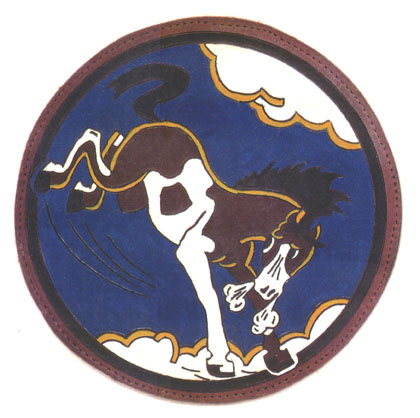 |
|
522nd Fighter Squadron (formerly 16th) Above
patch from Charles Dills website Someone designed a patch and had an
artist on the Isle of Capri paint it on canvas. I had one and it is the
one on the jacket in the picture on the right. It was too fragile and
rapidly got ruined. So someone had it reproduced on leather with burned
outlines and a "paint-by-number" kind of coloring, also done
on the Isle of Capri. "Fireballs" |
523rd Fighter Squadron (formerly 17th) Above patch from Charles Dills website The patch
was the official 523rd patch. It was made there in Italy. The squadron
had a contest when we were in Gaudo, and that was the winner. The paper
work was sent to higher Hdqs. For some reason it never made it back to
Washington.
"Crusaders" |
524th Fighter Squadron (formerly 91st) Above patch from Charles Dills website "Hounds of Heaven" |
| The Fireballs, The squadron was activated Feb. l, 1940, at Barksdale Field, La., as the l6th Bombardment Squadron (Light). Its first aircraft were the B-18 and A-24. The unit was later redesignated the 522nd Fighter Bomber Squadron, and then the 522nd Fighter Squadron. During World War II, the 522nd saw action in the Southwest Pacific, Mediterranean and European theatres. Aircraft used by the unit included the A-24, A-20, A-36, P-40 and P-47. The 522nd was deactivated Nov. 7, 1945 at Camp Shanks, N.Y. | Crusaders, The squadron's history dates from Feb. 1, 1940, when it was activated at Barksdale Field, La., as the 17th Bombardment Squadron (Light). Its first aircraft was the B-18. During World War II, the squadron saw action in the Southwest Pacific, Mediterranean, and European Theatres. It was redesignated the 523rd Fighter Squadron on May 30, 1944. By the end of the war, the unit had been re-equipped successively with A-24, A-20, A-36, P- 40 and P-47 aircraft. The unit was deactivated at Camp Shanks, New York, on Nov. 7, 1945 | Hounds of Heaven, The 524th was activated January l5, l94l, at Hunter Field, Ga., as the 11th Reconnaissance Squadron flying B-l8 aircraft. It was redesignated as the 9lst Bombardment Squadron in l94l, the 524th Fighter-Bomber Squadron in l943, and as the 524th Fighter Squadron in l944. In World War II, the unit fought in the Pacific, Mediterranean and European theatres, flying A-20, A-24, A-36, P-40, and P-47 aircraft. The squadron was deactivated Nov. 7, l945, at Camp Shank, New York. |
When
the A-36s were pretty well depleted by attrition around mid-1944, all of the
27th FG A-36s were transferred to the 86th, and (the 27th was re-equipped with
P-40s.(I have
confirmed the P-40's)) Then when they were all used up, the 27th
wound up the war with P-47s.The 86th FBG , used white ID letters on the rear
fuselage. Their 527th FBS had a white diagonal stripe on the tail.
The 27th used a 2-letter code vertically on the tail; top letter identified
the squadron ( A-B-C ) lower letter the aircraft.
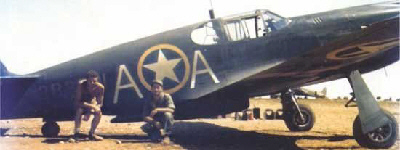
Early
(A-A), thought to be (42-83901)
John P. Crowder
The
RAF was concerned enough over the Mustang's general resemblance to the
Messerschmitt Bf-109 to give it special recognition markings, consisting of
yellow bands around the wings.
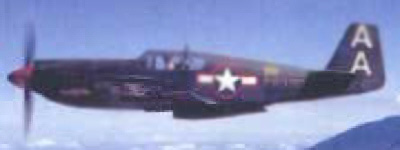
Later
(A-A) (42-83901, condemned salvage crash Apr 9, 1945)
John P. Crowder
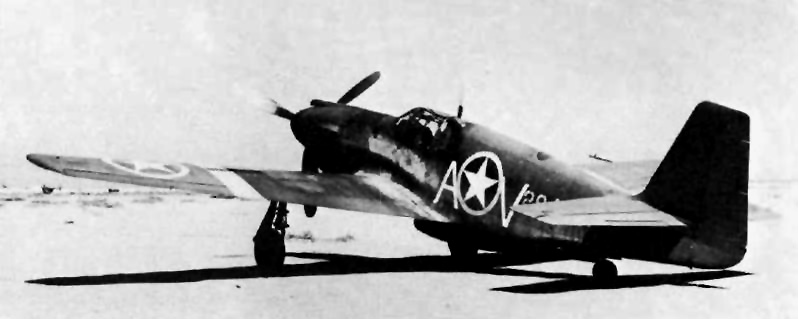
A-36A Apache, A-V thought to have been used by 522FS, 27FG
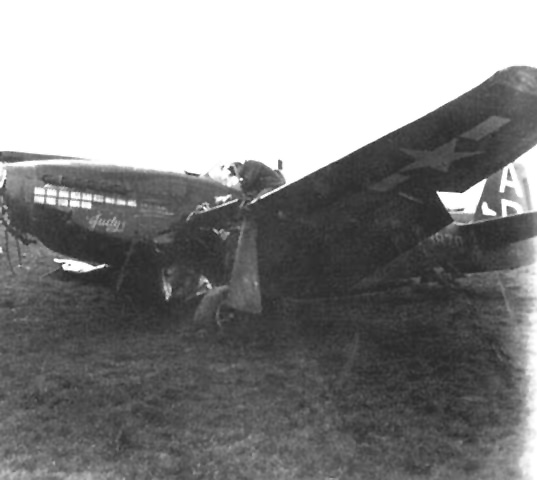
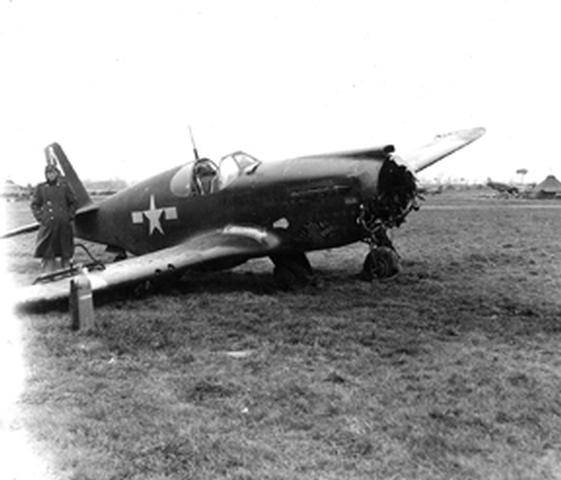
A-36A Apache, Judy, 42-83970 (last four digits easily seen on the fuselage), flown earlier in Jan 1944 by Robert Fromm, from Oklahoma. (Service # O-682627, 522nd Fighter Squadron, 27th Fighter Group, Entered the
Service from: Kansas, Died: 20-Oct-44, Buried at: Plot A Row 11 Grave 38, Florence American Cemetery, Florence, Italy. Awards: Distinguished Flying Cross with 2 Oak Leaf Clusters, Air Medal with 5 Oak Leaf Clusters) when it was badly damaged and crash landed, it is listed as condemned, 9 Jan 1944.Tiny Hunter, crew chief and staff, repaired the plane and Charles Dills relates this was the plane he was flying 19th or 22nd Feb. 1944 when the top section of a three piece canopy detached and struck him on the head causing the above forced landing accident. His crew chief, Tiny Hunter from Albuquerque, is leaning into the cockpit to take out the clock and remove the prized rear view mirror. Because I have "lightened' the first picture unfortunately you cannot make out Mount Vesuvius rising over the cowl. The 27th FG was based at Pomigliano, Italy, at the time.
The plane was a 522nd Squadron airplane (as seen by the top letter "A") coded either B or D
The red surround to the Star and Bar was eventually changed to a deep blue colour this would more commonly be seen with the 86th FG as they "won" (see below) the A-36A for their Group.
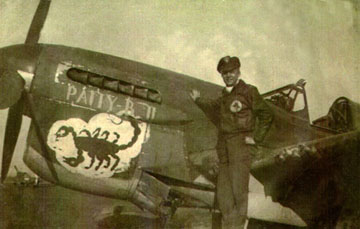
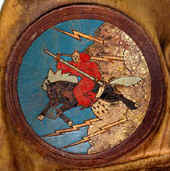
Chas Dills with his P-40 Warhawk, Patty B II., Coded Q, ( P-40, 41-19873, lost 24 April 1944 522 FS, (27th FG), Curtiss P-40F-15-CU Warhawk. Next picture is a close up, of his 522nd Squadron patch as seen on the A-2 Jacket. There is an entry in Hi Sherman's diary that reads "4-23-44 Charlie Dills cracked up on take-off today. What a mess. One of the wings went under the taxi strip steel mat, which damn near cut the plane in two. Dills walked away - uninjured - another miracle."
It
takes about 120 airplanes to keep a group going and we couldn't get any
replacements. Only 500 were made in the beginning. There was a training
group in Baton Rouge LA, a group in Burma (The only other A-36 user was
the 311th Fighter Bomber Group, based in India.) and two groups in Italy. We were
losing planes for one reason or another and we and our sister group, the 86th
were down to around 60 planes each. It was getting increasingly difficult to
operate. So someone came up with a great idea. The two group commanders would
flip a coin and the winner would get all the airplanes. We lost.
Having flown P-40's in the States, I was one of
the pilots that were taken to various dumps around Italy picking up war-weary
P-40's and bringing them back home!
My P-40 had a scorpion painted on it, left over we believe from one of the
squadrons of the 33rd Fighter Group ( actually was 57th FG
USAAF, 64th (Black Scorpions) FS, ). We didn't paint any of our planes
because they were temporary. An exception of course was mine with the name
Patty B II painted on it. She was the girl I was stuck on in high school, and
I believe was the only one that wrote me a couple letters while I was
overseas. It was our way of hanging on to things back home.
Began operations with Twelfth AF in Jun 1943 and served in the Mediterranean theater until the end of the war.
Redesignated 27th Fighter-Bomber Group in Aug 1943, and 17th Fighter Group in May 1944.
Maintenance and support personnel went by sea to North Africa while aircrews and the A-20s flew to South America then across to North Africa, In North Africa, the A-20s were sent to other groups and the 27th Bomb Group was redesignated as the 27th Fighter-Bomber Group and reequipped with the North American A-36 Invader dive bomber. Assigned to Korba, Tunisia, the 27th FBG flew its first combat missions of the war on June 6, 1943.
The 27th served in the Mediterranean Theater of Operations (MTO) until the end of the war. It was redesignated the 27th Fighter Group in May 1944 when the group converted first to the Curtiss P-40 Warhawk, then to the Republic P-47 Thunderbolt aircraft.
Participated in
the reduction of Pantelleria and Lampedusa. Supported ground forces during the
conquest of Sicily.
Covered the landings at Salerno and received a DUC for preventing three German
armored divisions from reaching the Salerno beachhead, 10 Sep 1943.
Supported Fifth Army during the Allied drive toward Rome.
Took part in the invasion Southern France and assisted Seventh Army's advance
up the Rhone Valley, receiving a DUC for helping to disrupt the German
retreat, 4 Sep 1944.
Took part in the interdiction of the enemy's communications in northern Italy,
and assisted in the Allied drive from France into Germany during the last
months of the war.
Source: http://www.armyairforces.com/dbgroups.asp?Group=50
| Aircraft | ||||||||||||||||||||
|
||||||||||||||||||||
| History | ||
| Constituted as 27th Bombardment Group
(Light) on 22 Dec 1939. Activated on 1 Feb 1940. Sailed for the
Philippine Islands on 1 Nov 1941 and arrived at Manila on 20 Nov. The
group's planes (A-24's), which had not arrived by 7 Dec, were diverted
to Australia after the Japanese attack on the Philippines. The group's
commander and 20 pilots who were flown from Luzon to Australia to get
the aircraft did not return because of the deterioration of the
situation in the Philippines; some of these pilots saw service in Java,
Feb-May 1942, before they were assigned to another group. The men left
on Luzon served as infantrymen in the battles of Bataan and Corregidor;
though a few managed to escape, most were either killed or taken
prisoners of war by the Japanese. The 27th group was transferred,
without personnel and equipment, from Australia to the US in May 1942. Remanned and equipped with A-20's. Trained in the US until Nov 1942. Moved to North Africa. Converted to A-36 aircraft. Began operations with Twelfth AF in Jun 1943 and served in the Mediterranean theater until the end of the war. Converted to P-40's in Jan 1944 and to P-47's in Jun 1944. Redesignated 27th Fighter-Bomber Group in Aug 1943, and 27th Fighter Group in May 1944. Participated in the reduction of Pantelleria and Lampedusa. Supported ground forces during the conquest of Sicily. Covered the landings at Salerno and received a DUC for preventing three German armored divisions from reaching the Salerno beachhead, 10 Sep 1943. Supported Fifth Army during the Allied drive toward Rome. Took part in the invasion Southern France and assisted Seventh Army's advance up the Rhone Valley, receiving a DUC for helping to disrupt the German retreat, 4 Sep 1944. Took part in the interdiction of the enemy's communications in northern Italy, and assisted in the Allied drive from France into Germany during the last months of the war. Returned to the US, Oct-Nov 1945. Inactivated on 7 Nov 1945. Activated in Germany on 20 Aug 1946. Assigned to United States Air Forces in Europe and equipped with P-47's. Transferred, without personnel and equipment, to the US in Jun 1947. Assigned to Strategic Air Command. Equipped with P-51's in 1947, F-81's in 1948, and F-84's in 1950. Redesignated 27th Fighter-Escort Group in Feb 1950. Moved to the Far East late in 1950 for temporary duty with Far East Air Forces during the Korean War. Operated first from a base in Korea and later from Japan, supporting ground forces, escorting bombers, and flying armed reconnaissance missions and counter-air patrols. Returned to the US in Jul 1951. Inactivated on 16 Jun 1952. |
||
| Campaigns | ||||||||||||||||||||||||||||||||||||||||||||||||||||||||||||||||||||||||||||||||||||
| Air Combat, EAME Theater, Sicily, Naples-Foggia, Anzio, Rome-Arno, Northern France, Southern France, North Apennines, Rhineland, Central Europe, Philippine Islands, | ||||||||||||||||||||||||||||||||||||||||||||||||||||||||||||||||||||||||||||||||||||
| Decorations | ||||||||||||||||||||||||||||||||||||||||||||||||||||||||||||||||||||||||||||||||||||
| Stations | ||||||||||||||||||||||||||||||||||||||||||||||||||||||||||||||||||||||||||||||||||||
|
||||||||||||||||||||||||||||||||||||||||||||||||||||||||||||||||||||||||||||||||||||
| Commanders | ||||||||||||||||||||||
|
||||||||||||||||||||||
Home] [Nominal Roll 1940-45] [March Of The Gladiators] [Gladiators] [K Flight] [112 Sqdn Personnel] [Claims] [Bases 1939-1946 ] [Bill Barwick] [Plane Losses 1940 -45] [Prisoner of War] [In Memory of] [Operations Room Book] [ Log Book Extracts] [112 Plane Codes] [Memories] [Letters Home] [RAF Map Napoli 40/14] [[Allied Air Forces in MTO 1942/43]] [USAAF Honor Rolls 1942-1943 MTO] [US Dispatches] [Photos ]
